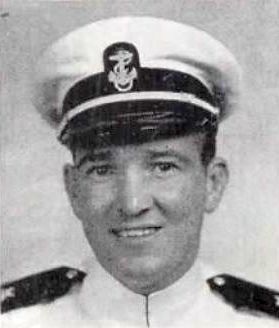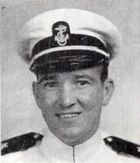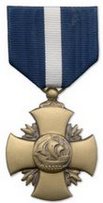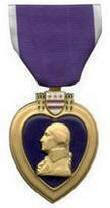Johnny "Red" Roberts
| Date and Place of Birth: | September 2, 1914 Boaz, Alabama |
| Date and Place of Death: | June 4, 1942 at sea near Midway |
| Baseball Experience: | Minor League |
| Position: | Outfield |
| Rank: | Ensign |
| Military Unit: | Scouting Squadron Six (VS-6) US Navy |
| Area Served: | Pacific Theater of Operations |
From the Rose Bowl to the Battle of Midway, former minor league outfielder Johnny Roberts was an all-American hero.
John Q. Roberts was born on September 2, 1914 in
Boaz, Alabama. He was the son of J. Grover and Deany Roberts. The family
lived in Sand Mountain, Alabama, until they sold their house and moved
to Guntersville in 1915, where Grover planned to start a business.
Unfortunately, the business was not successful and the earnings from the
sale of the house was quickly lost.
On April 24, 1917, when John was not yet three
years old, there was a domestic dispute between his parents involving
Deany’s alleged relationship with local man Earl Luttrell.
On July 21, 1917, Grover was shot to death and his
wife, Deany, was wounded in her arm. Deany told the police that her
husband had shot her then turned the gun on himself. But a coroner's
jury found that Deany unlawfully killed her husband, and further stated
that Earl Luttrell was an accessory before the fact.
Deany was indicted on murder in the first degree,
but was declared not guilty when the trial concluded on October 19,
1917.
Deany and her three children moved to Birmingham,
Alabama, where she married Oscar Lybrand, who was 26 years her senior.
Johnny graduated from West End High School in Birmingham in 1934, where
he was a star baseball and
football player. He won a scholarship to the University of Alabama,
where he played third base and outfield on the baseball team and was a
fullback in football, playing in the Rose Bowl on New Year’s Day 1938 in
the Crimson Tides’ 13-0, defeat at the hands of the University of
California Golden Bears.
Roberts competed in baseball and track at Alabama
in 1938, before signing with the Spartanburg Spartans of the Class B
South Atlantic League following graduation. He was sold to the Macon
Peaches of the same league in August, but left
the team after four games to play football for the Southern All-Stars
collegiate team against the NFL’s Chicago Bears, scoring a touchdown in
the 32-18 loss before 12,000 at Legion Field.
In 1939, Roberts started the season with the
Meridian Scrappers of the Class B Southeastern League, appearing in
three games before returning to the Macon Peaches and appearing in 13
games. He joined the Southeastern League’s Pensacola Fliers, in June,
appearing in 94 games and batting .279.
Roberts was sold to the Montgomery Rebels of the
Southeastern League in January 1940, but chose not to play baseball that
summer. He applied for Aviation Training in the US Naval Reserve in the
late summer of 1940, and enlisted in the V-5 aviation program on October
14, 1940. He reported to NRAB Miami, Florida for 30-day elimination
flight training, which he successfully completed. He then began flight
training as a Naval Aviation Cadet at NAS Pensacola, Florida, in January
1941, where he played baseball as well as completing his primary flight
training and receiving his designation as a naval aviator in the summer
of 1941. He attained the rank of Ensign in September 1941, and reported
for temporary duty with the Advanced Carrier Training Group in Norfolk,
Virginia for training in fleet-type planes and carrier-landing
qualification.
He travelled by rail to San Francisco and sailed on
the transport ship SS President Hoover bound for Hawaii. He arrived at
Honolulu in March 1942, and was assigned to NAS Kaneohe Bay. Roberts was
temporarily assigned as a replacement pilot to USS Saratoga's
shore-based Bombing Squadron Three (VB-3).
For the next month, Ensign Roberts learned how to
fly the Douglas SBD-3 Dauntless dive bomber. On March 18, 1942, VB-3
temporarily replaced Scouting Squadron Six on board the carrier USS
Enterprise, and she steamed out of Pearl Harbor on April 8. Five days
later, the Enterprise met with the carrier USS Hornet, which had her
deck full of Douglas B-25 bombers – the aircraft of the famed Doolittle
Raid. On April 18, Roberts was one of four SBDs that were launched from
the Enterprise to conduct a search for enemy vessels. Roberts spotted a
Japanese fishing boat, Nanshin Maru, at 0745. He tried to dive on the
125-foot-long boat but had to abort his first run when a Grumman F4F
Wildcat got in his way. On his second run, he dropped a 500lb bomb, but
it sailed over the target. Coming around for the third time, Roberts and
AMM2 Clarence Zimmershead, the rear-seat radioman/gunner, strafed the
ship with machine guns.
The Doolittle Raid of April 18, 1942, was the first
air raid by the United States to hit mainland Japan. All 16 bombers were
lost and 11 crewmen were either killed or captured. But although the
military significance of the raid was minimal, it proved to be a
substantial morale booster for the American people.
On April 25, 1942, Roberts was one of four pilots
transferred to Scouting Squadron Six (VS-6) on the USS Enterprise. On
May 28, the Enterprise left Pearl Harbor to stop the anticipated
Japanese assault on Midway Atoll. Early on the morning of June 4, 1942,
planes from the Enterprise, Hornet and Yorktown went to intercept and
attack the Japanese carrier fleet approaching Midway. According to
members of his squadron, Roberts had said beforehand that he would score
a hit even if he had to fly his plane straight into the target.
Fourteen SBD dive bombers formed the attack. Ensign
Roberts and his rear-seat gunner, Aviation Ordnanceman First-Class
Thurman Swindell, were sixth to dive on the Japanese aircraft carrier
Kaga, which had already been set afire from bow to stern. Roberts’ plane
was damaged by flak during his dive, but he was able to release his
bomb. However, his plane was seen to slam into the sea several hundred
yards to starboard of the Kaga.
Newspaper headlines of the time stated that Roberts
had intentionally crashed his plane into the Kaga, as he had previously
said he would. His squadron mate, Ensign Eldor Rodenburg later said, "We
all believe he kept his word." Whether Roberts intentionally tried to
crash into the Kaga, lost control after the plane was hit by flak, or
was wounded and unable to control the plane, we will never know.
In November 1942, Johnny Roberts was posthumously
awarded the Navy Cross for “extraordinary heroism and courageous
devotion to duty.”
In November 1943, the USS John Q. Roberts, a
high-speed transport ship, was named in his honor.
Roberts body was never recovered and he is
remembered at the Honolulu Memorial in Hawaii. His mother, Deany, lived
to the age of 95, and passed away in Birmingham, Alabama, in 1990.
|
Year |
Team |
League |
Class |
G |
AB |
R |
H |
2B |
3B |
HR |
RBI | AVG |
| 1938 | Spartanburg Spartans | South Atlantic | B | 49 | - | - | - | - | - | - | - | - |
| 1938 | Macon Peaches | South Atlantic | B | 4 | - | - | - | - | - | - | - | - |
| 1939 | Meridian Scrappers | S'eastern | B | 3 | - | - | - | - | - | - | - | - |
| 1939 | Macon Peaches | South Atlantic | B | 13 | 41 | 5 | 12 | 1 | 1 | 1 | 4 | .293 |
| 1939 | Pensacola Fliers | S'eastern | B | 94 | 359 | 53 | 100 | 15 | 1 | 2 | 29 | .279 |

Date Added November 23, 2024
Thanks to Jack Morris for "discovering" Johnny Roberts.
Baseball's Greatest Sacrifice is associated with Baseball Almanac
Baseball's Greatest Sacrifice is proud to be sponsored by



